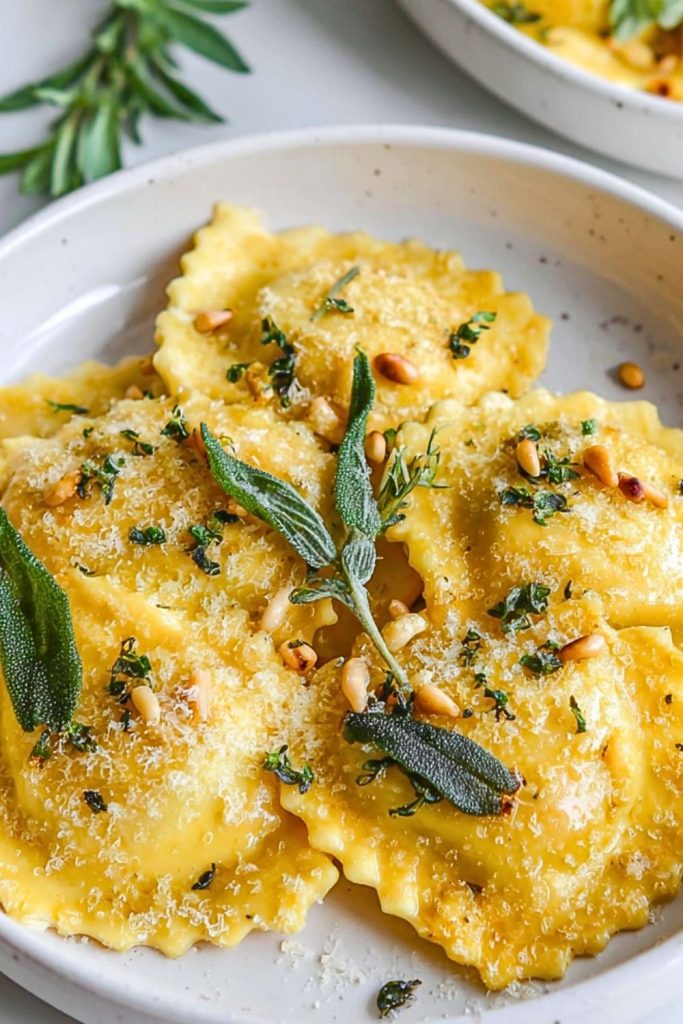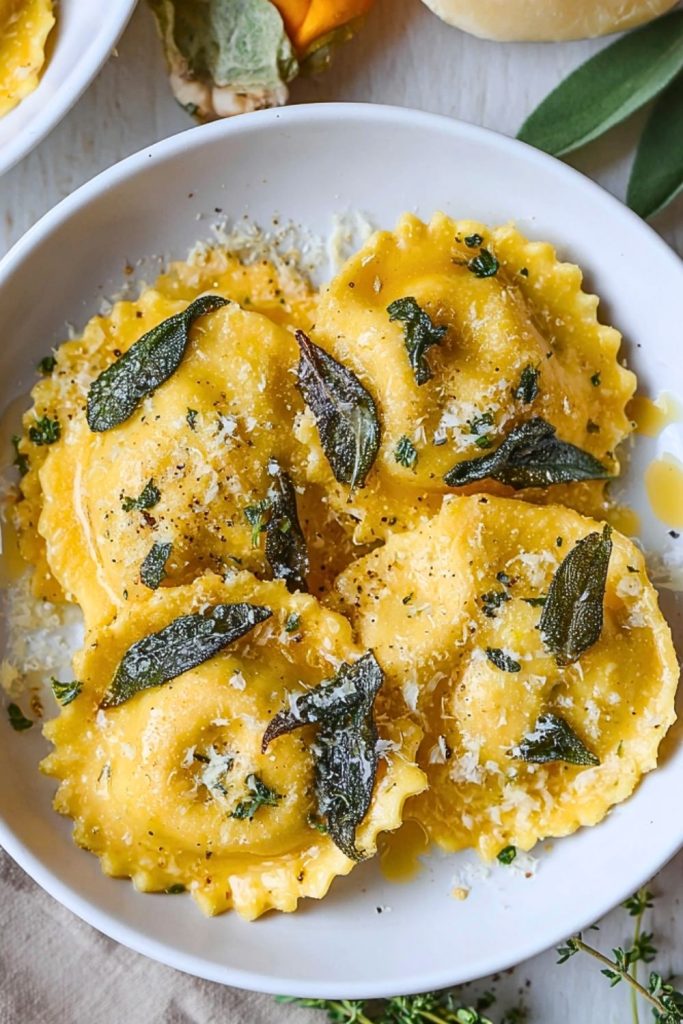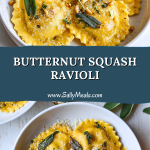Golden, delicate pillows of pasta filled with creamy roasted butternut squash, seasoned with nutmeg and a touch of parmesan—Butternut Squash Ravioli is the ultimate cozy dish that brings rustic charm and gourmet flair together on one plate. This Italian-inspired classic combines earthy, sweet, and savory elements, highlighted by the brown butter sage sauce that drapes each ravioli with an aromatic warmth.

Whether you’re preparing a special dinner for guests or treating yourself to something soul-satisfying, this dish turns an everyday meal into something memorable. Toasted pine nuts add a delightful crunch, fresh sage infuses every bite with herbal brightness, and grated parmesan finishes it all with a subtle sharpness that elevates the squash’s natural sweetness. It’s simple elegance at its best.
Why You’ll Love This Butternut Squash Ravioli
- Comfort meets sophistication: A rich, velvety filling inside delicate homemade or store-bought pasta.
- Perfect for any season: Butternut squash brings autumnal coziness, but this dish shines all year round.
- Balanced flavors: The sweetness of the squash pairs beautifully with salty cheese and the nutty bite of brown butter and sage.
- Make-ahead friendly: Prep the filling or even the ravioli in advance for an easier mealtime.
- A showstopper: It looks impressive on the plate, making it great for dinner parties or romantic evenings in.
Preparation Phase & Tools to Use (Essential Tools and the Importance of Each Tool)
Making Butternut Squash Ravioli is a rewarding experience, especially when you have the right tools by your side. Whether you’re crafting the pasta from scratch or using store-bought ravioli, these tools will streamline your process and ensure your dish comes out just right.
- Large Baking Sheet: Crucial for roasting the butternut squash evenly. Roasting brings out its natural sweetness and enhances the flavor of the filling.
- Food Processor or Blender: Essential for blending the roasted squash into a creamy, lump-free filling.
- Mixing Bowls: You’ll need these for combining the squash with cheese and seasonings.
- Rolling Pin or Pasta Machine (if making pasta from scratch): Helps roll out pasta dough to the perfect thinness.
- Ravioli Stamp or Cutter: Creates uniform ravioli with sealed edges, preventing the filling from leaking during cooking.
- Large Pot: Needed for boiling the ravioli. A wide pot ensures they don’t crowd and stick together.
- Slotted Spoon: Ideal for gently removing ravioli from boiling water without tearing.
- Non-stick Skillet: For preparing the brown butter sage sauce—non-stick helps avoid burning the butter and sticking herbs.
Preparation Tips
- Roast your squash well: Caramelization from roasting enhances both texture and flavor. Avoid steaming or boiling if you want a deep, nutty sweetness.
- Cool before blending: Let the squash cool slightly before pureeing so the steam doesn’t make the filling too wet.
- Use chilled filling: A cold filling is easier to spoon onto pasta sheets or store-bought wrappers and won’t spread too much during assembly.
- Dust your surface: Whether you’re using fresh pasta or wonton wrappers, dusting with flour prevents sticking and makes assembly easier.
- Seal well: Press out all air around the filling before sealing ravioli to prevent them from bursting while boiling.
- Toast nuts last minute: Pine nuts can go from golden to burnt in seconds—toast them right before serving for peak crunch and flavor.
Ingredients for This Butternut Squash Ravioli
Here’s everything you’ll need to create this elegant, flavor-packed dish. You can use homemade or store-bought pasta sheets or ravioli wrappers based on your time and skill level.
For the Filling:
- 1 small butternut squash (about 2–3 cups roasted flesh)
- 1 tablespoon olive oil (for roasting)
- Salt and black pepper, to taste
- ¼ teaspoon ground nutmeg
- ½ cup grated Parmesan cheese
- ¼ cup ricotta cheese (optional, for extra creaminess)
For the Ravioli Dough (if making from scratch):
- 2 cups all-purpose flour
- 3 large eggs
- 1 tablespoon olive oil
- A pinch of salt
Alternatively, use 20–24 fresh pasta sheets or wonton wrappers.
For the Brown Butter Sage Sauce:
- 6 tablespoons unsalted butter
- 10–12 fresh sage leaves
- 2 tablespoons pine nuts (lightly toasted)
- Additional grated Parmesan, for serving
- Fresh cracked pepper, to taste
Optional: A drizzle of good-quality balsamic glaze or truffle oil for a gourmet finish.

Step 1: Roast the Butternut Squash
Preheat your oven to 400°F (200°C). Slice the butternut squash in half lengthwise, scoop out the seeds, and place it on a baking sheet lined with parchment. Drizzle with olive oil, sprinkle with salt and pepper, and roast for 40–45 minutes until fork-tender and lightly caramelized. Let it cool slightly before scooping out the flesh.
Step 2: Prepare the Filling
In a food processor, combine the roasted squash, Parmesan cheese, ricotta (if using), nutmeg, salt, and pepper. Blend until smooth and creamy. Taste and adjust seasoning. Transfer the filling to a bowl and chill while prepping the pasta.
Step 3: Make the Pasta Dough (Skip if Using Pre-made Wrappers)
On a clean surface, make a mound with the flour and form a well in the center. Crack the eggs into the well, add olive oil and a pinch of salt. Gradually mix flour into the eggs using a fork, then knead for 8–10 minutes until smooth. Wrap in plastic and let rest for 30 minutes.
Step 4: Roll and Fill the Pasta
Roll out the dough into thin sheets using a pasta machine or rolling pin. Place small spoonfuls of the chilled filling about 1 inch apart on one sheet. Cover with another sheet, pressing around each mound to seal and remove air. Cut with a ravioli cutter or knife. Seal edges well and dust with flour.
Step 5: Cook the Ravioli
Bring a large pot of salted water to a boil. Gently add ravioli and cook for 2–4 minutes or until they float and are tender. Remove with a slotted spoon and set aside.
Step 6: Make the Brown Butter Sage Sauce
In a skillet over medium heat, melt the butter. Once it begins to foam, add sage leaves. Cook until the butter turns golden and aromatic, and the sage is crisp (about 2–3 minutes). Add pine nuts and swirl for a few seconds.
Step 7: Assemble and Serve
Toss the cooked ravioli gently in the brown butter sage sauce. Plate and top with extra Parmesan, fresh black pepper, and optional balsamic drizzle or truffle oil. Serve warm and enjoy!
Notes
- Ricotta is optional: If you prefer a more pronounced squash flavor, skip the ricotta. If you want a creamier texture, include it.
- Make-ahead tip: The squash filling can be made up to 2 days in advance. Store in an airtight container in the fridge.
- Freeze extras: Uncooked ravioli freeze beautifully. Lay them flat on a tray to freeze, then store in bags. Boil directly from frozen—just add an extra minute.
- Browning the butter: Watch closely—it can go from golden to burnt fast. You want a nutty aroma and amber color.
- Use quality Parmesan: Freshly grated Parmigiano-Reggiano really elevates the flavor of the finished dish.
Watch Out for These Mistakes While Cooking
- Over-roasting or under-roasting the squash: Too much roasting can make the squash dry, while undercooking leaves it stringy and bland.
- Using wet filling: Moist filling makes sealing the ravioli difficult and can cause them to burst during boiling.
- Not sealing ravioli tightly: Trapped air causes them to break open in water. Press gently around the filling to release air.
- Overcooking ravioli: Boiling too long can cause the pasta to fall apart. Remove as soon as they float and are just tender.
- Burning the butter: Don’t walk away during the sauce stage. The butter can go from brown to bitter in seconds.
- Skipping the flour dusting: Whether using pasta sheets or wonton wrappers, dusting prevents sticking and tearing during assembly.
What to Serve With Butternut Squash Ravioli?
The rich, slightly sweet profile of Butternut Squash Ravioli pairs well with dishes that contrast or complement its creamy texture and earthy depth. Here are eight tasty suggestions to round out your meal beautifully:
8 Recommendations
- Arugula Salad with Lemon Vinaigrette
A peppery, citrusy salad offers a refreshing contrast to the richness of the ravioli. - Garlic-Roasted Broccolini
Adds crunch and a hint of bitterness, balancing the sweet filling and buttery sauce. - Crispy Sage & Pancetta Chips
Enhance the sage notes in the sauce and add savory texture. - Toasted Baguette with Herbed Butter
Perfect for sopping up any leftover brown butter from your plate. - Balsamic Glazed Beets
Their earthiness and sweetness echo the squash while adding color and depth. - Chardonnay or Pinot Noir
A crisp white or light red wine cleanses the palate without overpowering the dish. - Creamy Cauliflower Soup
As a starter, it keeps the meal cozy and luxurious. - Pear and Walnut Salad
Pears add sweetness, walnuts bring crunch, and a light vinaigrette balances everything nicely.
Storage Instructions
Refrigeration:
Cooked ravioli can be stored in an airtight container in the refrigerator for up to 3 days. To reheat, gently warm in a skillet with a bit of butter or a splash of broth to maintain their texture.
Freezing:
Uncooked ravioli freeze very well. Arrange them in a single layer on a parchment-lined tray and freeze until solid. Then transfer to a zip-top bag or freezer-safe container. They’ll keep for up to 2 months. Cook directly from frozen—add 1–2 extra minutes to the boiling time.
Sauce Storage:
The brown butter sage sauce can be made in advance and refrigerated in a sealed container for 3–4 days. Reheat gently in a pan until melted and bubbly.
Estimated Nutrition
Per serving (4–6 ravioli with sauce):
- Calories: 420
- Fat: 22g
- Saturated Fat: 11g
- Carbohydrates: 42g
- Fiber: 4g
- Sugars: 5g
- Protein: 12g
- Cholesterol: 85mg
- Sodium: 380mg
Note: Nutrition may vary based on pasta thickness, cheese type, and exact portion size.
Frequently Asked Questions
1. Can I use canned butternut squash instead of fresh?
Yes, but fresh roasted squash offers a deeper, caramelized flavor. If using canned, make sure it’s 100% squash (not pie filling), and drain any excess moisture.
2. What pasta alternatives work if I don’t make it from scratch?
Wonton wrappers are a great shortcut. They’re thin and cook quickly, though slightly more delicate than pasta dough.
3. Can I make this dish gluten-free?
Absolutely! Use gluten-free pasta dough or wrappers and ensure all ingredients (especially the flour) are certified gluten-free.
4. How do I prevent the ravioli from sticking after boiling?
After draining, toss them gently in a little butter or olive oil before plating to keep them separate and glossy.
5. Is this dish suitable for vegetarians?
Yes, it is vegetarian if you use rennet-free Parmesan or a similar vegetarian-friendly hard cheese.
6. Can I prepare this ahead for a dinner party?
Definitely. Make the filling and ravioli a day ahead. Store them on a floured tray in the fridge or freeze. Prepare the sauce just before serving for the best flavor.
7. What can I use instead of pine nuts?
Toasted walnuts or hazelnuts work beautifully and offer a different, slightly more robust nutty flavor.
8. Is it possible to bake the ravioli instead of boiling?
Not recommended. Boiling keeps the pasta tender and prevents drying. However, cooked ravioli can be baked briefly with sauce for a gratin-style finish.
Conclusion
Butternut Squash Ravioli is more than just a cozy dish—it’s a culinary experience that blends sweet, savory, and nutty flavors into one elegant bite. Whether you’re crafting it from scratch or using smart shortcuts, the result is always impressive. With silky squash filling, golden brown butter sage sauce, and a touch of Parmesan, it’s the perfect plate for comforting nights and special gatherings alike. Try it once, and it might just become your favorite way to enjoy butternut squash.

Butternut Squash Ravioli
- Prep Time: 30 minutes
- Cook Time: 45 minutes
- Total Time: 1 hour 15 minutes
- Yield: 4 servings 1x
Description
Golden pillows of pasta filled with roasted butternut squash, blended with nutmeg and parmesan, then draped in brown butter sage sauce. This comforting yet elegant dish is perfect for cozy dinners or special occasions.
Ingredients
For the Filling:
- 1 small butternut squash (2–3 cups roasted)
- 1 tbsp olive oil
- Salt & pepper to taste
- 1/4 tsp nutmeg
- 1/2 cup grated Parmesan
- 1/4 cup ricotta (optional)
For Pasta Dough (or use wrappers):
- 2 cups all-purpose flour
- 3 large eggs
- 1 tbsp olive oil
- Pinch of salt
For the Sauce:
- 6 tbsp unsalted butter
- 10–12 fresh sage leaves
- 2 tbsp pine nuts (toasted)
- Extra Parmesan & black pepper
Instructions
- Roast squash at 400°F: Halve, seed, oil, season, roast 40–45 mins.
- Cool, scoop flesh, blend with cheese, nutmeg, salt & pepper. Chill.
- Make pasta dough: mix flour, eggs, oil, salt. Knead 10 mins. Rest 30 mins.
- Roll out dough or use wrappers. Spoon filling, cover, seal, cut.
- Boil ravioli 2–4 mins until they float. Remove gently.
- Brown butter in skillet, add sage, toast until crisp. Add pine nuts.
- Toss ravioli in sauce, plate, top with cheese & pepper. Serve warm.

